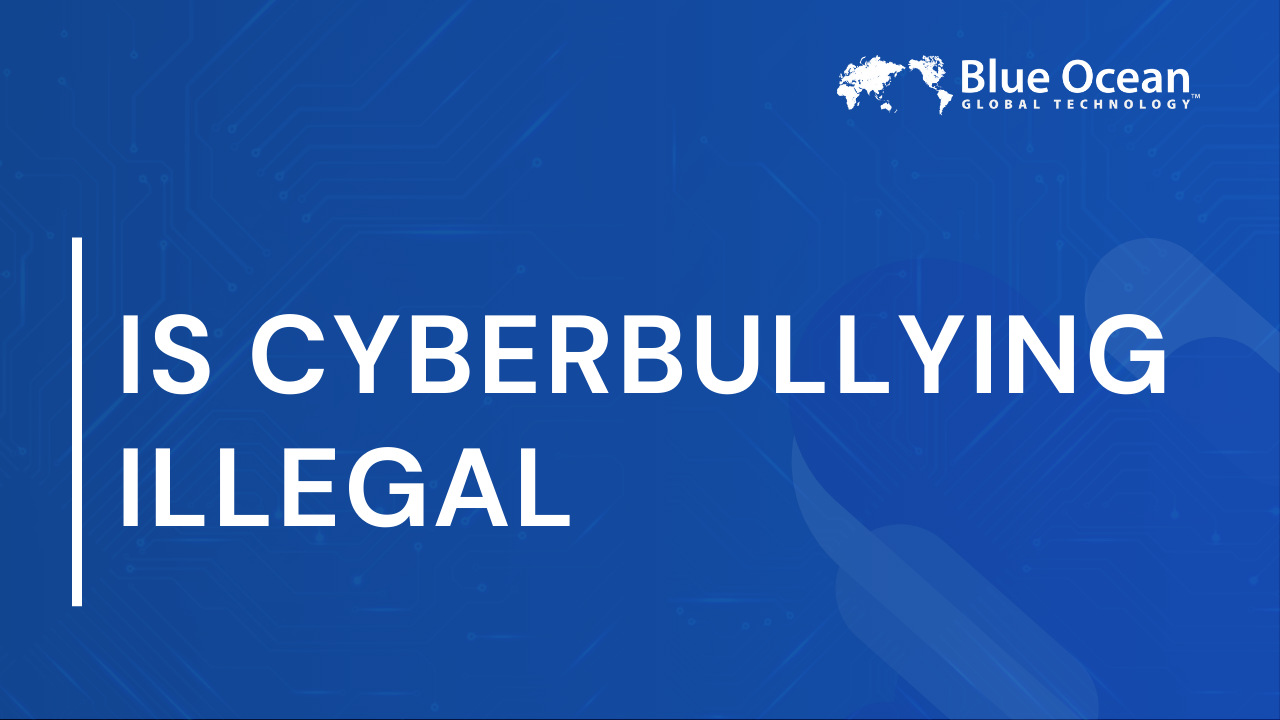“Cyberbullying” has been acknowledged as an illegal act in several countries. However, its status as an “offense” varies from region to region. For instance, Canada has the strictest approach to cyberbullying and awards punishment that range from device confiscation to imprisonment. On the other hand, cyberbullying is treated within the broader concept of harassment or bullying in the United Kingdom (UK).
In the United States of America (US), there are no federal laws against it. However, more than 50% of US states have included it as an offense within their existing harassment laws.
Cyberbullying can take different forms. Some of its most prevalent manifestation include:
- Harassment through insult or threat sent over as messages, email or posts
- Spreading rumours on social media
- Outing someone’s sensitive information without their consent
- Comments/ messages that ask an individual to take their life
- Comments/ messages that ask an individual to take their life

Bullying undertaken over the internet can leave a deeper emotional scar than traditional forms of bullying. Victims of such harassment can find themselves dwelling in depression and self-harming thoughts.
In the recent decade, the US has witnessed highly publicized incidents of adolescent suicides that occurred due to unaddressed cyberbullying. In response, almost every US state has included criminal sanctions in their harassment laws to counter cyberbullying. An individual facing charges of cyberbullying needs to brace themselves for imprisonment and a fine.
What is Cyberbullying?
Cyberbullying is the act of harassing, intimidating or causing harm to an individual through the mode of digital technology. In the book, “Bullying Beyond the Schoolyard: Preventing and Responding to Cyberbullying” (Hinduja & Patchin), it defines as “willful and repeated harm inflicted through the use of computers, cellphones and other electronic devices”.
Even if a country lacks direct legislation on cyberbullying, it can be prosecuted under other laws. For example, if an offender spreads derogatory rumors against someone on the internet, they can be sued for internet defamation.
What is the act of cyberbullying?
The act of cyberbullying can include sending, posting, or sharing of demeaning, false or mean content to an individual. As per StopBullying.Gov, sharing a person’s personal or private information with the intent to humiliate them falls within the criteria of cyberbullying. Considerations should be placed on the fact that some of its forms become much more than civil wrong.
For instance, it is a crime to share/distribute intimate pictures of a person under 18 years of age under Section 2252 of Title 18, United States Code. If a person shares such a picture, they can face criminal charges under federal law.
An offender can undertake this illegal act through:
- Social media platforms
- Messaging applications
- Online chat rooms and discussion forums
- Emails
- Online gaming platforms and communities

Is Cyberbullying Part of Mental Health?
Cyberbullying can have a long-lasting impact on a person’s mental health. Usually, bullies attack an individual’s insecurity, thereby scarring their self-image and affecting their emotional health. As per JAMA Network’s study, youngsters subjected to cyberbullying are at a 50% increased risk of indulging in self-harming thoughts.
There is sufficient evidence that suggests that the impact of cyberbullying is more severe than traditional bullying. Unlike other bullying in the physical realm, online bullying follows a victim home. It is persistent and can also be permanent. Victims of online bullies often feel unsafe and become socially isolated. In certain cases, the impact of such harassment causes stress, anxiety and depression in a person.
Before symptoms of a mental crisis turn into self-harming thoughts, it is important to stay vigilant about warning signs. Following signs indicate that a person might be experiencing cyberbullying:
- Being upset, stressed or nervous while using devices or receiving notifications
- Sudden avoidance of phone or computer usage
- Becoming secretive about their online activities
- Withdrawal from their social groups or reluctance to go to school/college
- Changes in mood or appetite
- Changes in sleep patterns
- Personality and behavioural changes
- Downfall in grades or in activity levels
Cyberbullying haunts its victims, especially if it occurs in the form of defamation. In such instances, the country’s defamation law can be relied upon. Victims can find solace in the civil remedy and can claim emotional distress damages from their bullies.

Is Cyberbullying a Crime?
In the US, cyberbullying is treated mostly as a civil wrong rather than a criminal offence. However, if the acts undertaken violate federal law or existing harassment laws, criminal charges can also be pressed. Online bullying transcends into a crime if it involves following activities:
- Death threats or threats of assault
- Child pornography (producing, possessing, distributing intimate pictures of anyone below 18 years)
- Stalking
- Hate crimes
- Hacking someone’s computer/phone camera to capture their picture without consent
- Extortion
Is Online Harassment a Crime in the US?
At the federal level, certain forms of online harassment are addressed as a crime. Particularly, stalking, interstate threats, identity theft, hacking, and threads made over telecommunication.
How Many States in the US Have Cyberbullying Laws?
As per Statista’s data, 48 US states have electronic harassment laws that cover instances of cyberbullying. Moreover, 44 states have criminal penalties in place to counter severe forms of internet bullying.
How Many States is Cyberbullying Illegal in?
Almost all 50 states in the US have laws that make cyberbullying illegal, except for Wisconsin and Alaska. However, these two states have certain laws against traditional bullying. Every state has its own legal approach towards this subject. For instance, Florida has the “Jeffrey Johnson Stands Up for All Students Act” that prohibits all forms of bullying, including online bullying. Texas has David’s Law that criminalizes cyberbullying and California’s penal laws impose penalties against harassment done through electronic media.

Is Cyberbullying Illegal in California?
In California, cyberbullying is treated as a misdemeanor. According to California Penal Code § 653.2 PC, it is illegal to send messages or emails with the intent of causing reasonable fear for the safety of the recipient. Further, this provision makes it a crime to share personal identifying information of a person, including their pictures, without their consent.
Upon conviction, a person can face up to one year’ incarceration in county jail, or a $1000 dollar fine, or both.
Is Cyberbullying Illegal in Texas?
Texas implemented David’s Law in 2017 to criminalize cyberbullying. It is named in honor of David Molak, a high schooler who fell prey to cyberbullies and took his life. This law imposes criminal penalties on acts of bullying committed using the internet.
Additionally, there are separate provisions to punish harassment through phone calls/messages and online impersonation. Texas Penal Code Section 42.07 charges a person with harassment if they send messages with the intent to annoy, alarm, embarrass, or torment an individual. Texas Penal Code Section 33.07 criminalizes impersonation with the intent to harm, defraud, intimidate, create a website or send messages under the pretense of being someone else.
Speak to a Cyberbullying Attorney
Facing harassment online? Know your rights. Contact our legal team for a confidential consultation to explore legal remedies.
What Happens if You Are Accused of Cyberbullying?
If you are facing charges of cyberbullying, you can expect legal consequences such as fine and imprisonment. Although treated as a misdemeanor, its punishment can become severe if it results in death or injury. As a student charged with cyberbullying, you can face suspension or expulsion from your school.
Additionally, if acts undertaken violate sexual harassment laws or federal law provisions, the severity of the consequences will increase. In other words, tenure of imprisonment and/or fine amount will be amplified.
Cyberbullying Case Study
Megan Meier, a 13-year-old teenager, loved everything girls her age love. She liked swimming, fishing, rap music and boys. But she also struggled with weight issues and depression. After she changed schools, she joined a volleyball team and soon became online friends with a boy named John Evans.
She became acquainted with John, a 16-year-old boy, on Myspace. They spoke every day and eventually, Megan developed a crush on him. Suddenly, one day, Megan received a mean message from him stating that he didn’t want to be friends with her because she was mean to her friends. This single message started an avalanche of negative texts that showcased Megan in a horrifying light before her friends.
At the end, she received the final message that read, “…everybody hates you. Have a shitty rest of your life. The world will be a better place without you”. This text from John was the last message she read because she went to her closet and committed suicide.

John’s account disappeared from Myspace after the incident. Later, Megan’s parents were informed that John did not exist in real life. It was a fake account that Megan’s former friend made to get back at her. Even her mother participated in it, as a joke, and wrote the last message that Megan read before she took her life.
This incident happened in 2006 and drew national attention because there was no law that could punish the guilty parties. In response to the lack, Missouri passed a legislation that criminalized cyberbullying. Megan’s story highlights the impact of cyberbullying and the brutal results it can lead to. Further, it underscores the need to take immediate actions against such instances instead of struggling with it in silence.
Conclusion
Cyberbullying does not end when the victim goes back to their home. It lingers within the walls of their room; it stays within the devices that they call their own. In the age of the internet, laws have to cope with rampant and innovative spread of malice over publicly shared platforms.
Online harassment can cause such reputational harm the law enforcement cannot remedy. Therefore there is an emergent need for reputational management services that can offset the damage that laws cannot repair.
Blue Ocean Global Technology offers reputation management services that can counter the spread of negative information. Feel free to contact us today for further information.
Frequently Asked Questions
1. Is cyberbullying considered a crime under U.S. law?
Cyberbullying can be a crime depending on the severity, content, and jurisdiction. Many states have enacted laws criminalizing online harassment, threats, stalking, and distribution of harmful digital content.
2. What laws address cyberbullying in the United States?
Cyberbullying is addressed through a combination of state laws and federal statutes, such as the Computer Fraud and Abuse Act (CFAA), the Violence Against Women Act (VAWA), and various state-level cyber harassment laws.
3. Can someone be arrested for cyberbullying?
Yes. If the cyberbullying includes threats, stalking, or harassment, law enforcement can pursue criminal charges. Consequences may include fines, restraining orders, or jail time.
4. Is cyberbullying treated differently for minors and adults?
Yes. Many state laws provide specific protections for minors in school settings. Juvenile offenders may face school discipline, diversion programs, or juvenile court, while adults can face more severe criminal penalties.
5. What should I do if I’m a victim of cyberbullying?
Preserve all evidence (screenshots, messages, profiles), block the harasser, report the behavior to the platform, and consult a legal professional to explore civil or criminal options.
Learn How Cyberbullying Laws Apply to You
Understanding your legal options starts with knowing the law. Download our free guide on cyberbullying statutes and protections in your state.














